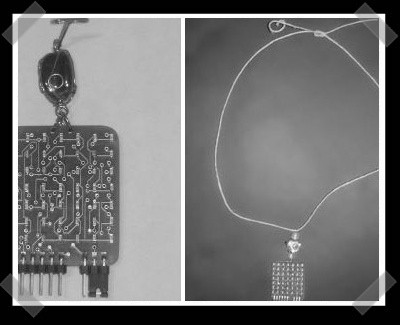
Here’s an interesting kit put together just to help you work on your SMD soldering skills. It’s got 49 SMD LEDs on the front with a programming header and switch jumper. The back has an ATtiny26L and a coin cell. At only 3V, power management is essential; all of the example programs are only addressing one LED at a time (imperceptible to the human eye). If you turn on too many LEDs at the same time, the voltage drop could cause the AVR to reset. Included example programs are a scrolling marque, bouncing balls, and Conway’s game of life. SparkFun has tutorials for regular SMD soldering and using a reflow skillet. The video below shows the kit builder attaching just one LED using the heat and slide method.
[youtube=http://www.youtube.com/watch?v=pMqHwzvvtjk&hl=en&fs=1&rel=0&color1=0x3a3a3a&color2=0x999999]
[thanks tom]














I prefer a pair of curved tweezers to align the surface mount part. Just tin the pads slightly, place the part on top, and heat it up.
@1
yeah, that is what I do, but I only tin one pad to hold it down. With multi pin chips, tin the opposite corners first and then heat to hold in place.
on the note about the reset… i’ve had atmegas reset on me with too low voltage. 3.3 v? project i’m working on needs attinys running at 3.3 volts, but my supplier has no stock of the low voltage chips (attiny85v). will the standard attiny85 reset at 3.3v? anybody know?
⢠Speed Grade for attiny85
â ATtiny25/45/85V: 0 – 4 MHz @ 1.8 – 5.5V, 0 – 10 MHz @ 2.7 – 5.5V
â ATtiny25/45/85: 0 – 10 MHz @ 2.7 – 5.5V, 0 – 20 MHz @ 4.5 – 5.5V
So lowest bound is 2.7v, only time I’ve got resets is when I didn’t have a .1uf or 1uf power cap close to the atmel.
@2
with a part so small, i find its easy to get both sides hot enough to melt the solder at once. Opposite corners is definitely the way to go with larger packages. An adjustable temperature iron is nice too.
Cant you just use a heatgun?
Much better video, I find it nice when the camera is in focus.
http://www.youtube.com/watch?v=3NN7UGWYmBY
just posted video SMD construction using ‘reflow skillet’ technique.
http://www.youtube.com/watch?v=WT46jkLKyoc
took about an hour to construct, time-compressed the video down to 9 minutes…
I built one of these, despite having a congenital tremor in my hands. I wrote about it at http://galacticstudios.org/component/content/article/2-electronics/22-smd
It’s a great kit! A nice cheap way to learn whether you can handle SMD.